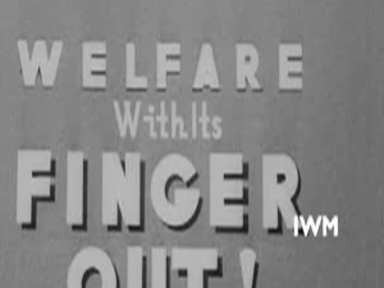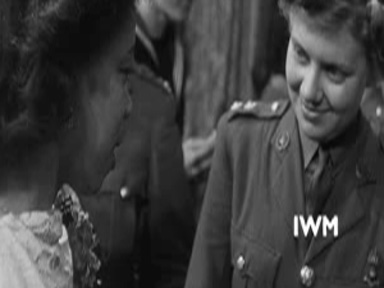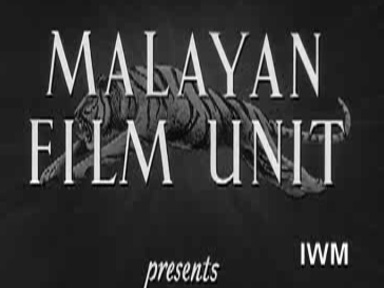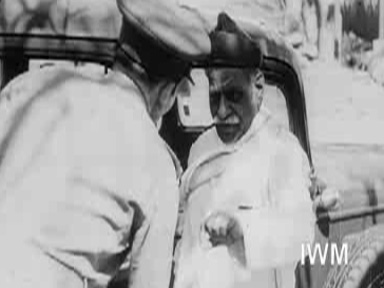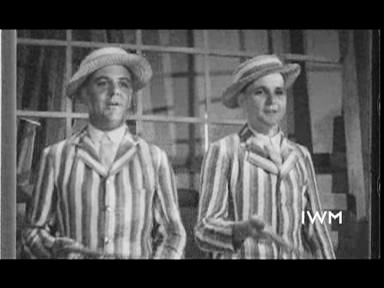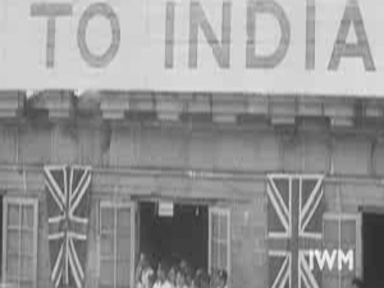The work of the Cinema Welfare Unit and the presentation of cinema ... . The Cinema Welfare Unit subsequently became the Army Kinema Section and ... servicemen and the efficiency of its Welfare Units. It presents a clearly structured narrative ...
Advanced Search
-
... 1944, 3).
-
I WILL SPEAK ENGLISH 1954

 ...
...An instructional film made on behalf of the Department of Social Welfare, demonstrating a new technique to teach English to illiterate ... ; such as the Police (‘Report on Department of Social Welfare and Community Development’, 1954, 15). The ...
-
... Colonies, had presented a new Colonial Development and Welfare bill to the House of Commons in February 1945, which ... 1 February 1945, 2.
‘Colonial Development Grants To Encourage Welfare And Research’, The Times, 13 December ...
-
AMENU'S CHILD 1950
 ... and the Social Development branch of the Department of Social Welfare, at which they decided to co-operate in forming a Mass ... , promoted a form of colonial governance predicated on social welfare and hygiene.
... and the Social Development branch of the Department of Social Welfare, at which they decided to co-operate in forming a Mass ... , promoted a form of colonial governance predicated on social welfare and hygiene.Promotional materials and reviews ...
-
... Batanagar. The company placed particular emphasis on the social welfare of workers, promoting education and mobility and a ... of a modern industrial company (with an emphasis on individual welfare) as it shows customers within a Bata shop, receiving pedicures ...
-
LEARIE CONSTANTINE 1945
 ... a piece of paper, apparently to illustrate his credentials as a welfare worker. Constantine is next shown on the factory floor, ... 1969 (Campbell, 2007, 116).
... a piece of paper, apparently to illustrate his credentials as a welfare worker. Constantine is next shown on the factory floor, ... 1969 (Campbell, 2007, 116).Learie Constantine: Welfare Worker and Cricketer illustrates the West ...
-
DUNLOP IN MALAYA 1955
 ... throughout the world, Dunlop in Malaya prioritised the welfare work and progressive development programmes of the ... the colonial archive, which promote ideals of corporate welfare together with policies of colonial ‘development&rsquo ...
... throughout the world, Dunlop in Malaya prioritised the welfare work and progressive development programmes of the ... the colonial archive, which promote ideals of corporate welfare together with policies of colonial ‘development&rsquo ... -
... measures taken against an outbreak of plague in Lagos, followed by footage of welfare exhibitions in Lagos in 1937.
The film opens with ... camera pans to reveal people visiting the 'Infant welfare exhibition 1937'. The exhibition contains stalls showing ...
-
WEST INDIES CALLING 1943

 ... Learie Constantine (the cricketer, then working as Welfare Officer for Ministry of Labour) who ... work as the Ministry of Labour’s Welfare Officer for the 200 Jamaican ... campaigned against this in his role as a welfare officer. Yet, here he talks of the ...
... Learie Constantine (the cricketer, then working as Welfare Officer for Ministry of Labour) who ... work as the Ministry of Labour’s Welfare Officer for the 200 Jamaican ... campaigned against this in his role as a welfare officer. Yet, here he talks of the ... -
... ), and then out on patrol. The welfare work of the British is again emphasised, ... importance of providing social services and welfare for the resettled population (Ramakrishna ... film places a huge emphasis on the welfare and development provided by the British ...
-
JUTE 1923

 ... , 96-97).
... , 96-97).The Titaghur mill was a leader in worker welfare: in 1923 it was alone in starting a scheme to provide ... the film presents it as illustrative of a concern with family welfare.
Although Jute aims to show Thomas Duff & ...
-
... responded to the film’s welfare message. Film User included ... Company emphasised its role in the welfare and development of Africa through other ... of Cleve, emphasised that ‘the welfare of these Africans and their families ...
-
... girl for one rupee and then taken her to a welfare centre (Hansard, 17 February 1944).
The final two items ... ;
Indian News Parade 74 highlights the welfare work performed by the British in Bengal. Having already ...
-
... reports emphasised the medical attention and welfare work provided for the African ... also due largely to the work of medical welfare and sanitary staff and, indeed ... main purposes. First, it emphasises the British welfare, sanitation and medical care offered ...
-
the GEN NO 14 1945

 ... to come to England. This rhetoric of British social welfare and paternal imperialism is particularly emphasised in ... used within The Gen as an example of the British welfare efforts within Burma. It represents a traditional British imperialism ...
... to come to England. This rhetoric of British social welfare and paternal imperialism is particularly emphasised in ... used within The Gen as an example of the British welfare efforts within Burma. It represents a traditional British imperialism ... -
CHISOKO THE AFRICAN 1949
 ... ;s sponsored books, but it also indicates an increasing emphasis on worker welfare, which was evident in post-war company reports. For ... of British development in Africa and emphasises the companies’ welfare work for its African employees. The film, ...
... ;s sponsored books, but it also indicates an increasing emphasis on worker welfare, which was evident in post-war company reports. For ... of British development in Africa and emphasises the companies’ welfare work for its African employees. The film, ... -
... and South East Asia’. She suggested that the welfare amenities available in Europe, or to American soldiers in Burma, were ... two items, it also serves an essential function in highlighting the welfare work of the British in Burma and the care offered ...
-
JUNGLE FORT 1953
 ... government emphasised both the operational success and the welfare developments provided through these forts. A newspaper ... Malaya and overseas. It highlights the proposed centrality of the welfare of the aborigines to its policies, showing the development ...
... government emphasised both the operational success and the welfare developments provided through these forts. A newspaper ... Malaya and overseas. It highlights the proposed centrality of the welfare of the aborigines to its policies, showing the development ... -
-
... of India to healthy recreation. His greatest contribution to India's welfare was the fostering of communal harmony and concord. The ... of Polish refugees was evidently intended to highlight the welfare work of the British, and to generate support for the ...
-
... rsquo;, while the footage of Polish refugees again emphasises the welfare efforts of the British, in contrast to the treatment meted out by ... ’ being fed, though this is not part of British welfare operations but rather part of ‘India’s age- ...
-
... new women’s hospital, stresses Britain’s ongoing social welfare plans in post-war India. Also included in the & ... over the Japanese and showing British and Indian co-operation in welfare work, the antagonistic anti-British sentiments of the event ...
-
MEN OF TWO WORLDS 1946
 ... population density will make them easier to marshal for his welfare plans. We are looking here at a place where reformism meets ... film realises something like Cary’s vision of progress, a utopian welfare state, with natives in trucks going over a new ...
... population density will make them easier to marshal for his welfare plans. We are looking here at a place where reformism meets ... film realises something like Cary’s vision of progress, a utopian welfare state, with natives in trucks going over a new ... -
... .
The farmer – with a financial interest in the welfare of his employees – does respond to the spread ... than the Africans themselves, who is responsible for their welfare.
Tom Rice (March 2008)
...
-
... tensions in the colonial response. The narrative is at pains to point out that ‘the administration and church welfare organisation raised funds to build settlements and model villages’, but it also reveals that the colonial authorities looked ...
-
... Empire (largely avoiding the word ‘Empire’), in which the Africans assumed greater responsibility for their own welfare and government. This is evident in the film, which promotes African leadership and envisages modern (British taught) skills ...
-
... -Fly country’ – seemingly bypasses the largely illiterate local audience, and presents the scheme as evidence of the welfare work of the British in Africa.
The film addresses topics prevalent within other BEKE films, such as the ...
-
... effects of Federation after 1953. The end of the war had seen the implementation of the 1940 Colonial Development and Welfare Act, which committed the Government to spending on the improvement of working conditions for colonial workers (Cooper, 2004, 302 ...
-
... as a historical record not just of the widespread community programmes introduced in Nigeria after the war through the Development and Welfare Act, but also of the ways in which the British sought to represent its own role in these developments. The film ...
-
EASTERN ROSE 1942
 ... technology – for example, in the overhead cable – and the continuing local traditions. It further highlights the welfare opportunities provided for the workers’ families at the village schools. By 1945 there were 55 school co-operatives ...
... technology – for example, in the overhead cable – and the continuing local traditions. It further highlights the welfare opportunities provided for the workers’ families at the village schools. By 1945 there were 55 school co-operatives ... -
FROM CANE TO CUBE 1950

 ... imperial industrial process.
... imperial industrial process.The film attempts, in common with other industrial process films of the time, to promote the welfare aspects of the industry. The audience sees the West Indian worker in his bed at home with pictures of Hollywood ...
-
... Parachute for Indian Troops in Italy’ – as an example of the newsreel’s emphasis on the British welfare of Indians overseas. As he notes, footage of Indian troops in Italy was often used, in part because of the difficulties in obtaining ...
-
... 67 emphasises the work of Indian troops overseas. As Philip Woods has shown, the film places a particular importance on the welfare of Indian troops, with the opening item showing members of the Defence Council visiting ‘our men in the hospitals ...
-
... ‘served…his fellow men’). Secondly, the film seeks to highlight the advances in medicine and the social welfare provided for the troops, through these blood transfusions. In particular here, the item stresses that blood transfusions are ...
-
MALAYA CELEBRATES 1953
 ... the ‘civilised’ nature of the security forces (paying due respect and drinking together). Further scenes highlight the welfare work of the British (‘the old and poor were not forgotten either and free meals were given to many’) and ...
... the ‘civilised’ nature of the security forces (paying due respect and drinking together). Further scenes highlight the welfare work of the British (‘the old and poor were not forgotten either and free meals were given to many’) and ... -
... , vets and agricultural officers threatened. This, then, is presented as an attack on British development, progress and social welfare. An attack that the commentator suggests was not widely supported (‘the sort of cooperation that prompted many ...
-
... , and when Africans are finally shown it is essentially as ethnographic subjects. The film offers little consideration of their welfare or social development, instead claiming that ‘many Southern Rhodesian Africans still live a tribal life. They are ...
-
THEY PLANTED A STONE 1953

 ... which shows local children running to school. Once more, the film highlights here the broader social changes and welfare developments introduced by the British.
... which shows local children running to school. Once more, the film highlights here the broader social changes and welfare developments introduced by the British.Tom Rice (April 2009)
‘They Planted a Stone&rsquo ...
-
... , arms and riot drill, the woman studies social welfare’ (Annual Report, 1957, 157). This gender- ... seen in large towns assisting in directing traffic, working in juvenile welfare centres, and assisting schoolchildren to cross busy roads’ ...
-
... , broadcasting on the BBC radio show ‘Calling West Africa’ and, with his interests ‘extended to social welfare and labour problems’, assumed ‘other responsibilities on behalf of the Colonial Office’ (Lambo, 1994, 158). ...
-
BEER AT ITS BEST 1955

 ... .
... .The immediate post-war period saw the introduction of the ‘Ten Year Plan of Development and Welfare for Nigeria’ in 1946 and an increasing attempt by the British administration to establish import-substitution industries in Nigeria ...
-
BETTER HOMES 1948
 ... cases ‘a very recent development’, as housing opportunities were now partially funded by the Colonial Development and Welfare scheme. The housing was constructed and managed by the municipalities, yet Atkinson acknowledged that ‘only a ...
... cases ‘a very recent development’, as housing opportunities were now partially funded by the Colonial Development and Welfare scheme. The housing was constructed and managed by the municipalities, yet Atkinson acknowledged that ‘only a ... -
BIKANER 1934

 ... . He oversaw the construction of the Ganga canal, which brought water to his rain deficient state. He also introduced a number of welfare schemes; developed hospitals and schools; introduced the first Chief Court in Rajasthan; and created a Representative ...
... . He oversaw the construction of the Ganga canal, which brought water to his rain deficient state. He also introduced a number of welfare schemes; developed hospitals and schools; introduced the first Chief Court in Rajasthan; and created a Representative ... -
DISTRICT OFFICER 1945

 ... social, economic and ethnographic topics with titles like Tree of Wealth, Kisan, Rural Bengal, All India Radio, Child Welfare, and Country Craft (Holmes 1946). In 1948, the IFI was reconfigured into the new Indian state with the remit of ...
... social, economic and ethnographic topics with titles like Tree of Wealth, Kisan, Rural Bengal, All India Radio, Child Welfare, and Country Craft (Holmes 1946). In 1948, the IFI was reconfigured into the new Indian state with the remit of ... -
... ’. ‘For the good of the country and its people, especially the coloured race, all Jamaicans who have the welfare of their country at heart should rise as one and do something to prevent their country and themselves being shown to the world in ...
-
... Britain’s publicly promoted liberal imperialism and came at a moment when Britain was increasing its expenditure on colonial welfare and development as well as seeking to retain influence and support within its African colonies. However, the British ...
-
... on training community leaders – the demonstration team in Togoland included a schoolmaster, a policeman, a medical assistant, and welfare officers – had a political function as well, as administrators hoped that incorporating an educated elite ...
-
... . In a tribute delivered from the Delhi Station of All India Radio on 6 February 1946, General Sir Noel Beresford-Peirse, the Welfare General in India, stated, ‘The Red Eagles of the Fourth Indian Division are flying home at last. From to-day their ...

